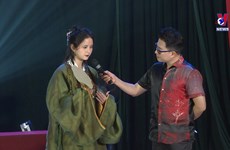Vietnamese kids in Malaysia learn mother tongue
More and more Vietnamese children were growing up in the country, but there were no Vietnamese class for them to learn their mother tongue.
 Children study at a free Vietnamese class in Malaysia (Source: VNA)
Children study at a free Vietnamese class in Malaysia (Source: VNA)Kuala Lumpur (VNS/VNA) – Tran Thi Chang, president of the Vietnamese women’s club in Malaysia, was worried about the fact that more and more Vietnamese children were growing up in the country, but there were no Vietnamese class for them to learn their mother tongue.
Efforts by Chang and several members of the club resulted in the first free Vietnamese class that opened last October in the living room of a flat on the second floor of the Pangsapuri Permai Puteri apartment building in Selangor.
Teaching language-teaching culture
On a sunny summer afternoon, nine Vietnamese children, some mixed Vietnamese-Chinese or Vietnamese-Malaysian, sat around a big table in the living room. Hands on the table next to their Vietnamese textbooks, the five- to eight-year-olds looked attentively at the teacher, Pham Hong Lam, who was explaining the lesson on a white board.
Truc Linh, the class-flat’s owner, said the 90-minute language classes are held twice a week. One class usually starts at 2.30-4pm for some 13 students unable as yet to read and write Vietnamese, and another class of about eight to 10 more advanced students runs from 4.30-6pm.
Lam is a volunteer teacher along with six other members of the Vietnamese women’s club in Malaysia. They help the two paid teachers, who used to be teachers of the Le Hong Phong and Trung Vuong high schools in HCM City.
The class is supported by the Vietnamese Embassy in Malaysia, and Vietnamese parents buy the textbooks. Most of the volunteer teachers are educated women who had good jobs in Vietnam, but had to leave their careers behind to move with their husbands who went to work in Malaysia.
“The teachers here used to work as doctors, professors, teachers back in Vietnam. Hence we get together to teach Vietnamese to the children, so that the human resources are not to be wasted,” Lam joked.
Lam and her family have been living abroad for nearly a decade, three years in Canada and another six in Malaysia.
“I have two children. My elder daughter is now a college junior while my son is in high school. The daughter can speak Vietnamese fluently, but not the son. That is what I regret,” said Lam, who was the former laboratory manager of Nike in Vietnam.
Lam believes teaching the Vietnamese language also means teaching Vietnamese culture to the children. “The children also get to wear ao dai (traditional dress) and sing traditional Vietnamese songs during festivals and events,” she said.
There has been a sharp increase in the number of Vietnamese coming to work in Malaysia, most of them are manual workers who hardly have time to teach Vietnamese to their own children, Chang said.
“The preservation of the mother tongue in the Vietnamese community in Malaysia has yet to receive proper attention, despite the fact that language is one of the most important connecting links between a generation of young Vietnamese born and growing up overseas and the culture and traditions of their home country,” she added.
According to the Department of Overseas Labour Management, hundreds of thousands of Vietnamese have worked in Malaysia since Vietnam started sending workers there 15 years ago, at times reaching up to 130,000.
Vietnamese parents’ support
Nhi Ca, a mother of three from the coastal central province of Ninh Thuan, is married to an oil company worker in Malaysia. Their twins were just two years old when they moved there. Another daughter was born in Malaysia, and after six years there, the three were barely able to read or write Vietnamese.
“The children can only study in international schools in English. I decided to take the kids here (to the Vietnamese class) so that they can use Vietnamese to talk with their grandparents and read Vietnamese fairy tales and books when they come back to Vietnam,” Ca said. “After taking the class, they now can write, listen and understand Vietnamese much better.”
Another Vietnamese mother, Chau Thi Diem Kieu, also took her two children to the class. The kids, 11 and nine years old, were of Vietnamese-Chinese origin and attended a Chinese school in Malaysia.
“At school, my children study three languages: English, Chinese and Malay. Though their study schedule was so tight, I still decided to let them take the Vietnamese class so that they won’t forget their home country’s language. My husband also supported the decision,” Kieu said.
Truc Linh, owner of the house where the classes are held, says the classes sometimes disturbed her family life but the demand and the necessity were so high that she could not refuse the Vietnamese women’s club request to borrow her living room.
More and more parents are asking to send their children to the class, Linh said, but her living room is not large enough and the study materials are limited. “We hope to receive more support from Vietnamese agencies and kind-hearted donors to be able to expand the Vietnamese class to other areas in Malaysia in order to sustain the Vietnamese language and culture for a younger Vietnamese generation,” Chang said.-VNA













